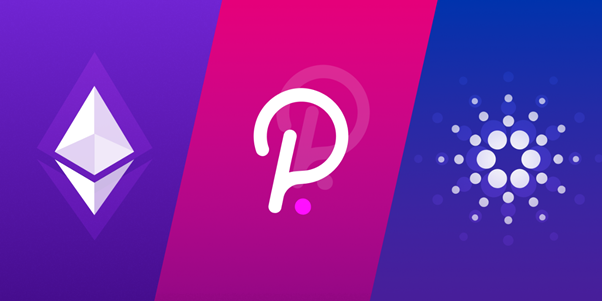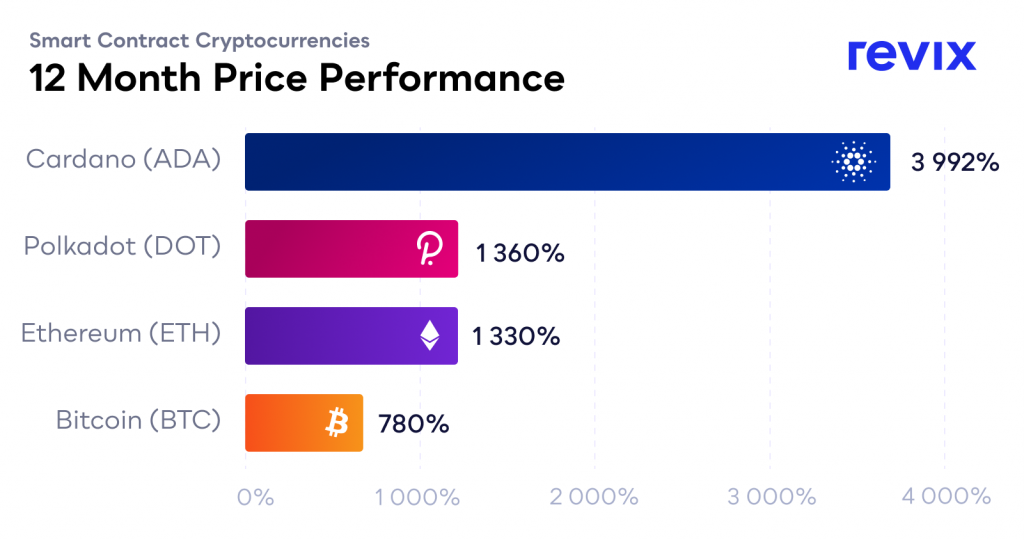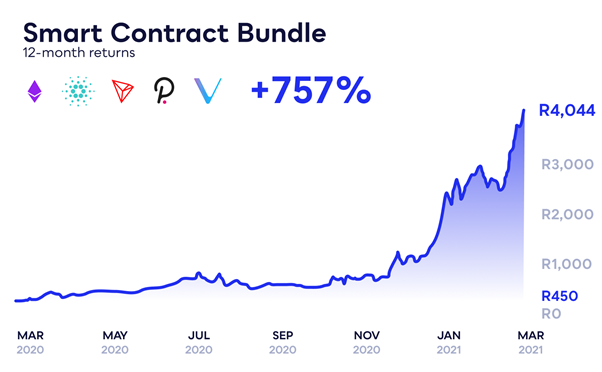South Africa’s esports scene is set for a major showdown as Hyprop and MTN introduce SHIFT COD, a Call of Duty tournament forming part…
Will Ethereum remain the second largest cryptocurrency?

Smaller cryptocurrencies like Polkadot and Cardano are challenging Ethereum’s dominance in the general-purpose blockchain space.
Ethereum’s 1 330% sprint over the last 12 months has been driven by the dramatic emergence of decentralised finance (DeFi) and non-fungible tokens (NFTs) but there are other cryptocurrencies that are nipping at its heels for dominance in this space.
Smaller cryptocurrencies like Polkadot and Cardano are challenging Ethereum’s dominance in the general-purpose blockchain space
Chief among them is Cardano, up more than 3 500% over the last year, and Polkadot, up 1 360% since it first traded in August 2020.
How are these cryptocurrencies different to Bitcoin?
Bitcoin’s primary purpose is to establish itself as a viable alternative to traditional fiat currencies (like rands or dollars) and was designed to be peer-to-peer digital cash. Today, Bitcoin is used as both a store of value (similar to gold) and a medium of exchange (like a normal currency).
Unlike Bitcoin, Ethereum, Polkadot and Cardano are cryptocurrency projects that provide the blockchain technology to do more than just act as a store value or digital cash. They offer multi-purpose blockchains for smart contracts and decentralised applications to run. This means that their blockchains can be used in multiple ways depending on what the end-user wants to accomplish.
As an example, ether – the native cryptocurrency of Ethereum’s blockchain – can be used as a digital currency just like Bitcoin, but that is not its primary purpose. Instead, ether’s primary purpose is to power its blockchain, much like oil is used to power the global transportation networks.
What are smart contracts and decentralised DApps?
Smart contracts and decentralised applications (DApps) sound intimidating but are actually simple concepts – they refer to some code or programmes that runs on top of a blockchain that automatically executes actions based on certain conditions.
As an example, if a food order is delivered (action completed) and the customer acknowledges receipt of the order (condition completed) then a payment can be authorised to the food delivery service (payment completed).
And, when you combine multiple smart contracts you get what is we now call decentralised apps, or ‘DApps’, which are really just like apps that run on your IOS or Android phone but instead run on top of a blockchain (like Ethereum, Polkadot or Cardano’s).
For these smart contracts to be executed or DApps to work, you have to use the native cryptocurrency on each blockchain to pay for the costs that miners charge to process and verify transactions. It’s through the increased usage of these blockchain networks, that the value of smart contract blockchain native cryptocurrencies gain in value. It’s simply a case of demand outpacing the supply of the cryptocurrency in question.
What does this all mean?
Ethereum, Cardano, and Polkadot offer blockchains that act as operating systems that enable smart contracts and decentralised applications to be developed and executed for lending, gaming, investing, and earning interest, not to mention purchasing insurance and trading between countries amongst millions of other potential use cases.
“The crypto market is already larger than Apple – and it’s not just Bitcoin and Ethereum – because there are going to be different applications for different things. If you’re looking to capitalise on trends shaping ‘the new normal’, then consider investing in assets that are global, generational, and digital – cryptocurrencies offer just that,” says Sean Sanders, Revix’s CEO and Founder.
Sanders describes a future where everything from contractual agreements to the payment of taxes to the tracking of tender-related funds is built into the plumbing that directly connects individuals and enterprises in a wide range of new kinds of business relationships.
“There is a big general-purpose blockchain battle underway. Ethereum, Cardano, and Polkadot together with EOS, VeChain, and Tron are competing to become the next global decentralised operating system for blockchain-based applications,” says Sanders. “This is one of the most exciting developments in the last several decades, akin to the development of the internet in the early 1990s and cloud technology of the early 2000’s. And one thing is for sure: there will be big winners and losers.
“People often hear the word cryptocurrency and all they think about is the currency part, but this is actually a misnomer, as not all cryptocurrencies are trying to become digital cash. This is exactly why we decided to launch our Smart Contract Bundle, which holds the top five smart contract enabled cryptocurrencies and is then automatically updated every month as the market changes. We view this as the safest and easiest way to securely invest in this fast-growing crypto theme without having to bet on which single cryptocurrency will become the next big success story.”
What’s next?
The Ethereum network has come to dominate this space but is facing some serious competition from the likes of Cardano and Polkadot – which were developed by some of the original founders of Ethereum. In fact, over the last 12-months, Cardano and Polkadot have played major catch-up as shown with the returns displayed below.

A battle for dominance of the smart contract space is underway
Charles Hoskinson was one of the co-founders of Ethereum who went on to found Cardano with the aim of solving some of the speed and scalability problems that have bedevilled Ethereum.
Gavin Wood, also a co-founder of Ethereum (together with Vitalik Buterin), which he described as “one computer for the entire planet,” left Ethereum in 2016 to set up the Polkadot network which, like Cardano, is more flexible and scalable than Ethereum.
Each of these is bidding to become the dominant player in the emerging Decentralised Finance (DeFi), Non-Fungible Token (NFT), and decentralised gaming arenas.
Not to be outdone, Ethereum is undergoing a major upgrade known as Ethereum 2.0, the main purpose of which is to increase transaction throughput from the current 15 transactions per second to tens of thousands per second. Cardano plans to push through 1 million transactions a second once its network is sufficiently developed – though when that will remain an open question.
EOS is another decentralised blockchain network that promises millions of transactions a second (it’s not there yet) and will allow smart contracts to be built on top of it with some fancy functionality, such as task scheduling and account recovery. EOS is also a cryptocurrency that is traded on several exchanges.
Tron is another decentralised blockchain platform with a slight difference. It was founded in 2017 by the Singapore-based Tron Foundation, headed by CEO Justin Sun, with the aim of allowing peer-to-peer transactions between content creators and content consumers, without middlemen.
While Netflix hosts content on its platform and charge the subscriber for watching movies, paying content creators a fee, Tron would allow anyone to upload digital content to its platform and the audience would pay the content creators directly.
The aim is to decentralise a heavily concentrated global media industry that acts as a gatekeeper for information and entertainment.
As shown below, Revix’s Smart Contract Bundle has performed exceptionally well over the last 12-months.

Other ways to intelligently invest in cryptocurrencies

Revix offers another two crypto bundles focused on specific investment themes:
Revix also offers a Payment Bundle, which provides exposure to the largest five payment-focused cryptocurrencies looking to compete with government-issued fiat currencies to make digital payments cheaper, faster, and more global. These cryptos include Bitcoin (BTC), Ripple (XRP), Litecoin (LTC), Bitcoin Cash (BCH), and Stellar (XLM).
A third bundle offered by Revix is the Top 10 Bundle, which spreads your investment over the top 10 largest cryptocurrencies as measured by market cap. As with all other bundles, the portfolio is re-balanced each month to make sure that each crypto is given a weighting of exactly 10%. This bundle achieved a remarkable 842% growth over the last 12 months.
You can also buy and sell USDC (a “stablecoin” fully backed by the US dollar) and a physical gold-backed token called PAX gold which provides legal ownership of an ounce of gold through Revix’s online platform.
Company Office is a subscription-based press office service.


